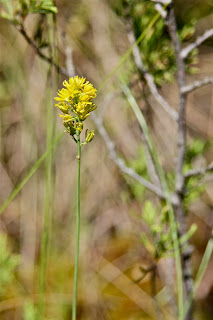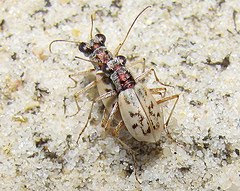Last July, Jim Stasz and Ed Boyd took Tom Feild and myself up to the Pine Barrens of New Jersey to look for plants. We found many great plants like the federally endangered American Chaffseed (Schwalbea americana) and the New Jersey state endangered Bog Asphodel (Narthecium americanum).

American Chaffseed

Bog Asphodel
We also saw many cool insects like Martha's Pennant (Celithemis martha)
Martha's Pennant
and my favorite sighting of the weekend, a Ghost Tiger Beetle (Ellipsoptera lepida).

Photo: Ben Coulter
The Ghost Tiger Beetle is a very scarce tiger beetle in the genus Ellipsoptera. These beetles are found only in very sandy habitats like coastal sand dunes and inland sand washes. Most of the New Jersey Pine Barrens is composed of sandy well drained soil. This is just the type of habitat to find Ellipsoptera lepida. Because of their white body and dark thorax if the Ghost Tiger Beetle isn't moving it becomes virtually invisible. It is often said that it is easier to see their shadow than the actual beetle.

Photo: Ben Coulter
The Ghost Tiger Beetle is scattered throughout the northeast and central United States. The map below shows some of the county distribution for Ellipsoptera lepida.

This map was taken from the USGS tiger beetle distribution site. All the Mid Atlantic states have or had Ghost Tiger Beetle populations. Normally these populations are restricted to the coast (North Carolina, Virginia, Maryland, and Delaware). New Jersey has records for eight of its 21 counties and quite a few are inland records. All of the Pennsylvania populations which were centered around Lake Erie are listed as historical. A survey conducted in New York from 1995 - 1998 found 13 populations in five counties.

Photo: Ben Coulter
This photo shows in great detail all the necessary identification points for the Ghost Tiger Beetle. The white elytron (back of the beetle) with dark maculations (markings on the back of the beetle). The head and thorax are bronzy with fine white setae (hairs) and the white legs are diagnostic.

Photo: Ben Coulter
Unfortunately, much of the habitat where these beetles live has been lost due to urbanization and industrialization. In the book A Field Guide to the Tiger Beetles of the United States and Canada, the authors state that they believe,
that 33 (15%) of the 233 named species and subspecies of tiger beetles in Canada and the United States may be declining at a rate that justifies their consideration for inclusion on the U.S. Fish and Wildlife Service's List of Endangered and Threatened Species. At present, only five of these are officially listed, and several others are under consideration for listing.
With our lands being under the constant threat of industry and urbanization it is important to keep an eye on nature. Will there be a significant impact on the ecosystem if the Ghost Tiger Beetle disappears? Probably not, but I feel that these creatures are our responsibility. Groups like the Nature Conservancy who set aside land for species just like the Ghost Tiger Beetle deserve our support. Fortunately, the land is preserved where we saw our lepida and the population is very strong.
All of the photos of Ellipsoptera lepida in this post were taken by my friend Ben Coulter in Ohio. Many more of his fine photographs can be viewed at his flickr site http://www.flickr.com/photos/somatochlora/
Below are listed a few books that are relevant to tiger beetles of the Mid Atlantic. All of these books can be purchased on Amazon.
A Field Guide to the Tiger Beetles of the United States and Canada: Pearson, Knisley, Kazilek, Oxford, 2006
A Field Guide and identification Manual for Florida and Eastern U.S.: Choate, University Press of Florida, 2003
The Biology of Tiger Beetles and a Guide to the Species of the South Atlantic States: Knisley, Schultz, Virginia Museum of Natural History, 1997
Here are a few websites that have tiger beetle info:
The USGS tiger beetle site has loads of info and lots of distribution maps
http://www.npwrc.usgs.gov/resource/distr/insects/tigb/index.htm
Giff Beaton's tiger beetle site has tons of photos
http://www.giffbeaton.com/Tiger_Beetles.htm
Bug Guide is the ultimate insect resource for North America. It has photos and informations on all the US tiger beetles.
http://bugguide.net/node/view/375
Mathew Brust's flickr site has awesome photos of lots of pinned specimens and live shots
http://www.flickr.com/photos/24608578@N00/sets/72157623022560586/
No comments:
Post a Comment